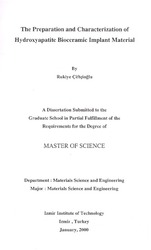Please use this identifier to cite or link to this item:
https://hdl.handle.net/11147/3914| Title: | The preparation and characterization of hydroxyapatite bioceramic implant material | Authors: | Çiftçioğlu, Rukiye | Advisors: | Harsa, Hayriye Şebnem | Publisher: | Izmir Institute of Technology | Abstract: | The use of hydroxyapatite (HA) powders and ceramIcs as a biomaterial was investigated in this work. A commercial HA powder was used for the preparation of HA ceramics and the adsorption of Bovine Serum Albumin (BSA) onto HA has been investigated.The powder and the sintered ceramics were characterized by TGA, DT A, Optical Microscopy, Microhardness Tester, XRD, and FTIR.The sintering studies have shown that it was possible to prepare porous ceramics above 800°C and dense ceramics at 1200-1250°C range.The HA powder lost about 5.5% by weight during heat treatment up to 1000DC and 80% of this weight loss is due to adsorbed water.The particle size of the powder was determined to be submicron whereas the grain sizes of the 1250°C sintered ceramic was in the 1-5 /l um range.A maximum Vickers Hardness of 585 Hv was determined for the 1250°C sintered 97.2% dense ceramic.XRD patterns of the powder and the 1250°C sintered ceramic were identical and almost phase pure. A small CaO peak was detected in the samples which was believed to be remnants of the powder preparation process.The adsorption of BSA onto HA has been studied as a function of time, protein concentration, pH, ionic strength, and HA solids loading. Adsorption experiments were also conducted with commercial alumina and zirconia ceramic powders. Uptake curves have shown that the adsorption process was almost completed in less than ten minutes Adsorption isotherms 'at different pH ( 4.5-7.4) have been obtained and analyzed using the Langmuir model. The Langmuir parameters qm ( maximum amount of protein adsorbed, mg BSA/g HA) and K' (affinity constant, mllmg BSA) have been calculated. qm decreased from 119 to 61.3 with the increase in pH from 4.7 to 7.4. A maximum of 46.1 for K' was determined at pH.5.6 and K' had the lowest value of 3.5 at pH.7.4. Electrostatic attractions were held responsible for the K' maximum at pH.5.6 since HA and BSA surfaces are oppositely charged. The presence of a considerably high amount of BSA adsorption on the HA surface at pH.4.7 where the protein should have close to zero net charge was attributed to hydrophobic effects. The amount of adsorption at equilibrium in the 4.5-5.8 pH range was determined to be twice of that in the 6-8 pH range. Almost 100% of the protein was recovered with a HA solids loading of 750 mg HA/50 ml solution at equilibrium for an initial BSA concentration of I mg BSA/ml solution. | Description: | Thesis (Master)--Izmir Institute of Technology, Materials Science and Engineering, Izmir, 2000 Includes bibliographical references (leaves: 91-94) Text in English; Abstract: Turkish and English xi, 98 leaves |
URI: | http://hdl.handle.net/11147/3914 |
| Appears in Collections: | Master Degree / Yüksek Lisans Tezleri |
Files in This Item:
| File | Description | Size | Format | |
|---|---|---|---|---|
| T000012.pdf | MasterThesis | 29.37 MB | Adobe PDF |  View/Open |
CORE Recommender
Page view(s)
84
checked on Jul 22, 2024
Download(s)
202
checked on Jul 22, 2024
Google ScholarTM
Check
Items in GCRIS Repository are protected by copyright, with all rights reserved, unless otherwise indicated.